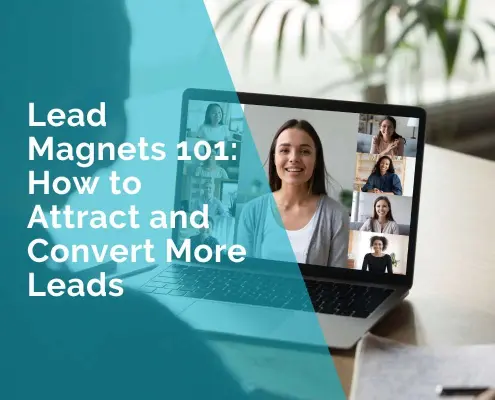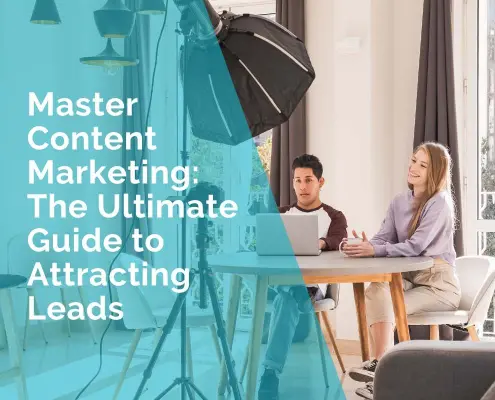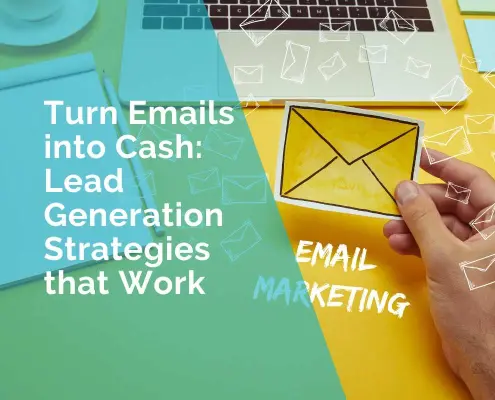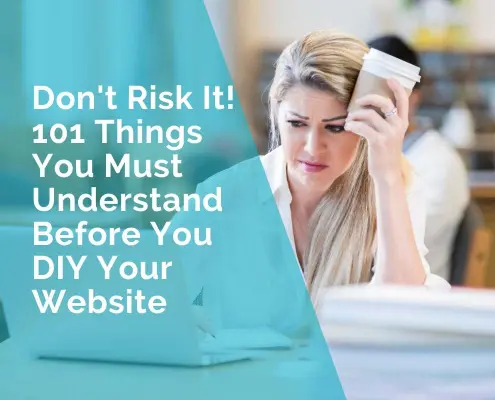Master Content Marketing: The Ultimate Guide to Attracting Leads
Understanding Content Marketing for Lead Generation
Content marketing is all about creating valuable and relevant content to attract and engage your target audience. Instead of directly selling your product or service, you offer helpful information that draws people in and builds their trust in your business. This approach helps you connect with potential customers in a more meaningful way.
For example, imagine you own a bakery. Instead of just sending out advertisements about your latest pastries, you could write a blog post on “10 Easy Baking Tips for Beginners.” This content is helpful and engaging, making people more likely to visit your bakery or sign up for your newsletter. This is how content marketing helps in generating leads.
How Content Marketing Attracts and Nurtures Leads
Content marketing attracts leads by providing useful information that your audience is looking for. When people find your content valuable, they’re more likely to share their contact details with you. For example, a fitness trainer might offer a free workout guide in exchange for an email address. This guide attracts people interested in fitness and begins a relationship with them.
Once you have leads, content marketing helps nurture these relationships by continuing to provide valuable information. For instance, after someone downloads the workout guide, the trainer might send follow-up emails with tips, success stories, and special offers. This ongoing communication keeps the leads engaged and more likely to become paying customers.
How Content Marketing Fits into Lead Generation
Content marketing is a key part of a lead generation strategy. It works alongside other methods like social media and email marketing. By creating useful content, you draw potential customers to your website or landing pages. From there, you can collect their contact information and continue to engage them through various channels.
For instance, a tech company might write articles about the latest gadgets and trends. They share these articles on social media and in email newsletters. As people read and engage with these articles, they may sign up for updates or download related resources. This way, content marketing supports the overall effort to find and build relationships with new leads.
Identifying Your Target Audience
Understanding your target audience is crucial for effective content marketing. Knowing who you’re creating content for helps you tailor your messages to meet their specific needs and interests. Here’s how you can identify your target audience:
1. Define Your Ideal Customer
Start by thinking about who would benefit most from your product or service. Consider factors such as age, gender, location, job title, and interests. For example, if you run a landscaping business, your ideal customers might be homeowners aged 30-60 who live in suburban areas and enjoy maintaining their gardens.
2. Techniques for Defining and Researching Your Target Audience
- Surveys and Questionnaires: Ask your current customers about their preferences and needs. This can provide direct insights into what they’re looking for. For instance, a fitness trainer could send out a survey asking clients about their fitness goals and challenges.
- Social Media Insights: Use social media analytics to see who is engaging with your content. Platforms like Facebook and Instagram offer detailed demographics about your followers. A boutique clothing store might find that their audience is primarily women aged 25-34, allowing them to tailor their content accordingly.
- Website Analytics: Tools like Google Analytics show who is visiting your site, what pages they’re looking at, and how long they’re staying. If a local bakery notices that most visitors to their website are searching for gluten-free options, they can create more content around that topic.
- Competitor Analysis: Look at who your competitors are targeting and what kind of content they’re producing. This can help you identify gaps in the market. For example, a tech company might notice that a competitor is successfully engaging with small business owners and decide to create content that addresses the tech needs of that audience.
3. Create Customer Personas
Develop detailed profiles of your ideal customers, known as customer personas. These personas are fictional characters that represent different segments of your audience. For example, a travel agency might have personas like “Adventure-Seeking Anna,” who loves outdoor activities, and “Relaxation-Retreat Rachel,” who prefers luxury beach vacations. Each persona will have different needs and interests, guiding how you create content for them.
4. Use Analytics Tools
Leverage analytics tools to gain insights into who is visiting your website and engaging with your content. For example, Google Analytics can show you the demographics of your website visitors, helping you understand which types of content are most popular and why.
5. Gather Feedback
Ask your current customers for feedback to learn more about their preferences. Surveys and customer interviews can provide valuable insights. For example, if you run a coffee shop, you might survey your customers about their favorite products and what content they’d like to see on your blog or social media.
6. Analyze Competitors
Look at what your competitors are doing to reach their audience. See what kind of content they’re creating and how their audience is responding. This can give you ideas about what works well in your industry and how you might attract similar customers.
Creating High-Value Content
Creating various types of content can help you reach a broader audience and keep your content fresh and engaging. Here are some common types of content and how they can be used to attract and nurture leads:
1. Blog Posts
Blog posts are a versatile and accessible form of content. They allow you to share your expertise, answer common questions, and provide valuable information. Regularly updating your blog can improve your search engine rankings and drive traffic to your website. For example, a landscaping business might write blog posts on topics like “Seasonal Lawn Care Tips” or “How to Design a Water-Efficient Garden.”
2. eBooks and Guides
eBooks and guides are in-depth resources that provide detailed information on a specific topic. They are great for capturing leads because you can offer them in exchange for contact information. For instance, a financial advisor could create an eBook titled “The Ultimate Guide to Retirement Planning” and offer it as a free download to website visitors who sign up for their newsletter.
3. Videos
Videos are highly engaging and can convey information quickly and effectively. They are perfect for demonstrating products, sharing customer testimonials, or providing how-to tutorials. For example, a fitness instructor might create workout videos that show proper exercise techniques or offer short, follow-along workouts.
4. Infographics
Infographics present information in a visually appealing and easy-to-understand format. They are great for simplifying complex data or processes. An example might be a tech company creating an infographic that explains the steps to secure a small business’s online presence.
5. Case Studies
Case studies showcase real-life examples of how your products or services have helped customers achieve their goals. They are powerful tools for building trust and credibility. A marketing agency might publish a case study detailing how they helped a client increase their online sales by 50% through a targeted advertising campaign.
6. Webinars and Online Workshops
Webinars and online workshops provide an interactive way to share your knowledge and connect with your audience in real time. They can be used to educate potential customers about your industry, products, or services. For example, a software company could host a webinar on “Best Practices for Data Security” to attract businesses interested in their security solutions.
7. Podcasts
Podcasts are a convenient way for your audience to consume content on the go. They can cover a wide range of topics and feature guest experts, customer stories, and industry news. A digital marketing firm might start a podcast series discussing the latest trends in social media marketing.
8. Social Media Posts
Social media platforms are ideal for sharing shorter content and engaging with your audience directly. Regular updates, promotions, and behind-the-scenes looks at your business can keep your audience engaged. For example, a restaurant could post daily specials, cooking tips, or photos of new dishes on their social media channels.
9. Email Newsletters
Email newsletters keep your audience informed about your latest content, promotions, and company news. They are a great way to nurture leads and keep your business top-of-mind. For instance, a travel agency might send out a monthly newsletter with travel tips, destination highlights, and special offers.
10. Whitepapers
Whitepapers are authoritative reports that delve deeply into a specific issue or topic. They are often used in B2B marketing to provide valuable insights and establish thought leadership. An IT consulting firm might publish a whitepaper on “Emerging Technologies in Cloud Computing” to attract potential clients interested in advanced tech solutions.
Providing Value
Providing value through your content means offering information, insights, and solutions that your audience finds genuinely useful. Here’s how you can ensure your content delivers real value:
1. Addressing Pain Points
Identify the common problems or challenges your audience faces and create content that offers solutions. For example, a home repair service might write a blog post on “How to Fix Common Plumbing Issues Yourself,” addressing the pain point of unexpected plumbing problems.
2. Offering Practical Tips and Advice
Content that offers actionable tips and advice can be incredibly valuable. If you run a marketing consultancy, you might share tips on “How to Improve Your Website’s SEO” or “Effective Social Media Strategies for Small Businesses.
3. Sharing Industry Insights
Providing insights into industry trends and developments can position your business as a thought leader. For example, a real estate agency could publish a market report on “The Current State of the Housing Market” to inform potential buyers and sellers.
4. Creating How-To Guides and Tutorials
Step-by-step guides and tutorials help your audience learn new skills or complete tasks more efficiently. A beauty salon might create video tutorials on “How to Achieve a Perfect At-Home Manicure” or “Top Hair Care Tips for Healthy Hair.”
5. Offering Free Resources
Free resources like templates, checklists, and worksheets can be highly valuable to your audience. For instance, a business coach might offer a downloadable “Business Plan Template” to help aspiring entrepreneurs get started.
6. Showcasing Success Stories
Highlighting customer success stories can provide social proof and inspire your audience. If you own a gym, you could share testimonials and transformation stories from your members, showing how your services have helped them achieve their fitness goals.
7. Engaging and Entertaining Content
Content that entertains while educating can keep your audience engaged. A pet store might create fun and informative videos featuring pet care tips and funny pet antics, making their content enjoyable and shareable.
8. Providing Exclusive Content
Offering exclusive content to your subscribers or loyal customers can make them feel valued. For example, a fashion retailer might send exclusive style guides or early access to sales to their email subscribers.
“The secret to attracting leads is not just creating content, but making sure it solves real problems for your audience“
Ivana Katz
Using SEO to Improve Content Visibility
Search Engine Optimization (SEO) is about making your content easy to find on search engines like Google. When done right, SEO helps your content show up higher in search results, which means more people can see and visit your website.
First, use keywords in your content. Keywords are the words and phrases people type into search engines when looking for information. For example, if you run a bakery, your keywords might include “best chocolate cake recipe” or “how to make sourdough bread.” Make sure these keywords appear naturally in your titles, headings, and throughout the content.
Next, write high-quality content. Google favours content that is helpful and well-written. Make sure your articles provide value, answer questions, and solve problems. For example, a gardening store could write a detailed guide on “How to Start a Vegetable Garden in Your Backyard” with step-by-step instructions and tips.
Also, optimize your images. Use clear, high-quality images with descriptive file names and alt text. Alt text is a brief description of the image that helps search engines understand what it’s about. For instance, if you have a picture of a tomato plant, the alt text could be “tomato plant growing in a garden.”
Lastly, make your content easy to read. Use short paragraphs, bullet points, and subheadings to break up the text. This makes it easier for visitors to read and understand your content. A financial advisor could use these techniques to create a user-friendly guide on “Managing Personal Finances.”
Incorporating Effective Calls-to-Action (CTAs)
A Call-to-Action (CTA) is a prompt that tells your audience what you want them to do next. It could be something like “Sign up for our newsletter,” “Download our free eBook,” or “Contact us for a free consultation.”
To create effective CTAs, be clear and direct. Tell your audience exactly what you want them to do and why it benefits them. For example, a fitness trainer might use a CTA like, “Join our online fitness community for free workout tips and support!”
Make your CTAs stand out by using contrasting colors and placing them in visible areas of your content. If you’re a clothing retailer, you might put a bright, bold “Shop Now” button at the end of your blog posts about the latest fashion trends.
Use action-oriented language. Words like “Get,” “Join,” “Try,” and “Learn” encourage people to take action. A software company could use a CTA like, “Get started with our free trial today and see how our software can help your business grow.”
Crafting Compelling Headlines and Meta Descriptions
Headlines and meta descriptions are the first things people see when your content appears in search results. They need to be catchy and informative to attract clicks.
For headlines, be clear about what your content offers. Use numbers, questions, and power words to make them interesting. For example, a travel blog could use a headline like, “10 Budget-Friendly Destinations You Need to Visit in 2024.”
Keep your meta descriptions brief but informative. They should summarize what your content is about and include your main keyword. A beauty salon might write a meta description like, “Learn the best skincare routines for glowing skin with our expert tips and tricks.”
Leveraging Different Content Formats
Different content formats can engage different segments of your audience. Each format has its pros and cons.
Articles are great for providing in-depth information. They are easy to share and can boost your SEO. For example, a legal firm could publish articles on “Understanding Business Contracts” to attract clients looking for legal advice.
Infographics present data in a visually appealing way. They are perfect for summarizing complex information and are highly shareable. A tech company might create an infographic showing “The Evolution of Smartphones” to engage tech enthusiasts.
Podcasts allow you to connect with your audience in a personal and conversational way. They are great for people who prefer listening over reading. A marketing consultant could start a podcast discussing “Marketing Tips for Small Businesses.”
Videos are highly engaging and can quickly convey information. They are ideal for product demonstrations, tutorials, and testimonials. A craft store could post videos on “DIY Craft Projects” to inspire and educate their customers.
To choose the right format, consider your audience’s preferences and the type of content you’re sharing. If you’re a restaurant, a mix of blog posts with recipes, videos showing cooking techniques, and infographics on nutrition facts could be effective.
Promoting Your Content
Once you’ve created great content, the next step is to promote it. Share your content on social media platforms where your audience is active. Use email marketing to send your latest blog posts or videos to your subscribers. Collaborate with influencers or other businesses to reach a wider audience.
For example, if you own a pet store, you could partner with a popular pet influencer to share your blog posts on pet care tips. If you’re a local café, you might promote your content through local food bloggers or community newsletters.
Promoting your content helps you reach more people, drive traffic to your website, and generate leads. By using these strategies, you can ensure your content not only gets seen but also engages and converts your audience.
Strategies for Distributing Content
Creating great content is just the first step; getting it in front of the right audience is just as important. Here are some strategies to help you distribute your content effectively:
Social Media
Sharing your content on platforms like Facebook, Twitter, LinkedIn, and Instagram can help you reach a broad audience. Each platform has its strengths. For instance, LinkedIn is excellent for B2B content, while Instagram is perfect for visual content like photos and videos. A local bakery could share recipes and behind-the-scenes photos on Instagram, while a business consultant might post articles and industry insights on LinkedIn.
Email Marketing
Sending your content directly to your subscribers through email can be very effective. You can use newsletters to share blog posts, videos, or special offers. For example, a fitness center could send a weekly newsletter with workout tips, healthy recipes, and upcoming class schedules.
Building Partnerships and Collaborations
Working with other businesses or influencers can help you reach a new audience. For example, a beauty salon could partner with a local fashion boutique to create and share content about the latest beauty and fashion trends. This way, both businesses benefit from each other’s audience.
Utilizing Paid Advertising
Sometimes, investing in paid ads can help your content reach a larger audience quickly. Platforms like Facebook Ads, Google AdWords, and sponsored posts on Instagram can target specific demographics. For example, an online course provider could use Facebook Ads to promote their new course to people interested in professional development.
Measuring and Analyzing Content Performance
Once your content is out there, it’s crucial to measure how well it’s performing. This helps you understand what’s working and what needs improvement.
Key Metrics to Track:
- Engagement: This includes likes, shares, comments, and time spent on your content. High engagement indicates that people find your content interesting and valuable. For instance, if a travel blog post about “Top 10 Travel Destinations for 2024” gets many shares and comments, it’s a sign that the content resonates with readers.
- Conversion Rates: This measures how many people take the desired action after consuming your content, like signing up for a newsletter, downloading an eBook, or making a purchase. A real estate agency could track how many people contact them after reading a blog post about “Tips for First-Time Home Buyers.”
Tools for Analyzing Content Performance:
- Google Analytics: Helps you track website traffic, user behavior, and conversions.
- Social Media Analytics: Platforms like Facebook, Twitter, and LinkedIn offer insights into how your content is performing on their sites.
- Email Marketing Tools: Tools like Mailchimp or Constant Contact provide metrics on open rates, click-through rates, and more.
How to Use Data to Refine and Improve Your Content Strategy:
By analyzing the data, you can see which types of content perform best and why. If you notice that your audience engages more with video content, you might decide to create more videos. For example, a local coffee shop might find that their how-to videos on making the perfect latte get more views and shares than their blog posts, leading them to focus more on video content.
Overcoming Challenges and Pitfalls in Content Marketing
Creating and sharing content isn’t always smooth sailing. Here are some common challenges and tips on how to overcome them:
Challenge 1: Consistency
Maintaining a consistent content schedule can be tough, especially for small business owners juggling multiple responsibilities. However, consistency is key to keeping your audience engaged and building trust.
Tip: Create a content calendar. Plan your content weeks or even months in advance. This helps you stay organized and ensures you always have something to share. For example, a local bakery could plan to post recipes every Monday and behind-the-scenes videos every Friday.
Challenge 2: Content Quality
Producing high-quality content regularly can be difficult. Poor-quality content can hurt your brand’s reputation and drive potential leads away.
Tip: Focus on quality over quantity. It’s better to post less frequently but ensure each piece of content is valuable and well-crafted. For instance, a small law firm might prioritize creating one in-depth blog post per month rather than several short, superficial ones.
Challenge 3: Audience Engagement
Engaging your audience can be challenging, especially if you’re not sure what they find interesting or valuable.
Tip: Listen to your audience. Pay attention to comments, feedback, and engagement metrics. Use this information to tailor your content to their preferences. A local gym might notice that their audience enjoys workout tips and motivational stories, leading them to create more of this type of content.
Challenge 4: Measuring Success
Knowing whether your content marketing efforts are paying off can be tricky. Without clear metrics, it’s hard to know what’s working and what isn’t.
Tip: Define clear goals and track relevant metrics. Use tools like Google Analytics, social media insights, and email marketing reports to measure your content’s performance. A small consulting firm might track how many leads they generate from their blog posts and social media campaigns.
Tips for Avoiding Common Mistakes That Can Hinder Lead Generation
Avoiding common mistakes can make your content marketing efforts more effective and lead to better results.
Mistake 1: Overloading Your Audience with Information
Too much information can overwhelm your audience and make your content hard to digest.
Tip: Keep it simple and focused. Break down complex topics into smaller, more manageable pieces. A financial advisor could create a series of short, easy-to-understand blog posts about budgeting, saving, and investing, rather than one long, complicated article.
Mistake 2: Ignoring SEO
Neglecting search engine optimization (SEO) can make your content hard to find, limiting its reach and impact.
Tip: Use basic SEO practices, like including relevant keywords, using meta descriptions, and optimizing images. An online retailer might use keywords like “affordable organic skincare” to help their blog posts rank higher in search results.
Mistake 3: Neglecting Mobile Users
Many people consume content on their mobile devices. If your content isn’t mobile-friendly, you could miss out on a large portion of your audience.
Tip: Ensure your website and content are mobile-responsive. A restaurant could make sure their menu and reservation system are easy to use on smartphones and tablets.
Mistake 4: Not Testing and Optimizing
Failing to test different content strategies and optimize based on results can lead to missed opportunities for improvement.
Tip: Regularly test different content types, formats, and distribution methods. Use the data to refine your strategy. For example, a small tech company might test different email newsletter formats to see which one gets the most opens and clicks.
Mistake 5: Ignoring Legal and Ethical Guidelines
Not complying with legal regulations (like GDPR or CAN-SPAM) can lead to serious consequences.
Tip: Stay informed about relevant laws and regulations. Make sure your content and marketing practices comply with them. A marketing agency should always get consent before adding someone to their email list and provide easy opt-out options.
Content marketing is a powerful tool for generating leads and growing your business. By understanding and addressing the challenges, avoiding common mistakes, and continually refining your strategy, you can create content that resonates with your audience and drives results. Start by getting to know your audience, planning high-quality content, and distributing it effectively. Measure your success, learn from your data, and adjust as needed. With the right approach, your content marketing efforts can help you connect with potential customers and build lasting relationships.
Resources and Tools
Tools:
- HubSpot: Marketing automation and CRM platform.
- Buffer: Social media management tool.
- Google Analytics: Web analytics service.
- Mailchimp: Email marketing service.
- BuzzSumo: Content research and performance tool.
- SEMrush: SEO and online visibility management platform.
- Canva: Graphic design tool.
- CoSchedule: Marketing calendar and management tool.
- Ahrefs: SEO and backlink analysis tool.
- Trello: Project management tool.
Books:
- “Content Inc.” by Joe Pulizzi
- “Everybody Writes” by Ann Handley
- “Killing Marketing” by Joe Pulizzi and Robert Rose
- “Made to Stick” by Chip Heath and Dan Heath
- “Jab, Jab, Jab, Right Hook” by Gary Vaynerchuk
- “Building a StoryBrand” by Donald Miller
- “The New Rules of Marketing and PR” by David Meerman Scott
- “Epic Content Marketing” by Joe Pulizzi
- “They Ask You Answer” by Marcus Sheridan
- “This Is Marketing” by Seth Godin
Podcasts:
- Content Inc. Podcast by Joe Pulizzi
- Marketing School by Neil Patel and Eric Siu
- Call to Action by Unbounce
- The Content 10x Podcast by Amy Woods
- Social Media Marketing Podcast by Michael Stelzner
- The Copyblogger Podcast by Tim Stoddart and Darrell Vesterfelt
- Content Heroes by Josiah Goff
- The Smart Passive Income Podcast by Pat Flynn
- The Marketing Book Podcast by Douglas Burdett
- Online Marketing Made Easy by Amy Porterfield
Frequently Asked Questions
What is content marketing for lead generation?
Content marketing for lead generation involves creating and sharing valuable content to attract and convert potential customers. This can include blog posts, videos, eBooks, social media posts, and more. The goal is to provide information that solves problems or answers questions for your target audience, encouraging them to engage with your brand and eventually become leads.
Why is content marketing important for lead generation?
Content marketing is crucial for lead generation because it helps establish your brand as a trusted authority in your industry. By providing valuable content, you can attract potential customers who are searching for information related to your products or services. This engagement increases the chances of converting these visitors into leads and, eventually, paying customers.
How can I create content that generates leads?
To create content that generates leads, focus on addressing the pain points and needs of your target audience. Conduct keyword research to understand what your audience is searching for and create content that answers their questions. Include clear calls-to-action (CTAs) that encourage readers to take the next step, such as downloading a resource, signing up for a newsletter, or requesting a consultation.
What types of content are most effective for lead generation?
Different types of content can be effective for lead generation, including:
- Blog posts: Informative articles that address common questions or problems.
- eBooks and whitepapers: In-depth resources that provide detailed information on a specific topic.
- Videos: Engaging visual content that can explain concepts or demonstrate products.
- Webinars: Live or recorded sessions that offer valuable insights and allow for audience interaction.
- Infographics: Visual representations of data or processes that are easy to share and understand.
How do I promote my content to generate leads?
Promoting your content involves sharing it across multiple channels to reach your target audience. This can include:
- Social media: Sharing your content on platforms like Facebook, Twitter, LinkedIn, and Instagram.
- Email marketing: Sending your content to your email list to keep them engaged.
- SEO: Optimizing your content for search engines to attract organic traffic.
- Paid advertising: Using PPC ads or sponsored posts to reach a larger audience.
How do I measure the effectiveness of my content marketing efforts?
To measure the effectiveness of your content marketing efforts, track key metrics such as:
- Traffic: The number of visitors to your website or specific content pages.
- Engagement: Metrics like time on page, social shares, and comments.
- Lead generation: The number of leads generated from your content, such as form submissions or downloads.
- Conversion rates: The percentage of leads that turn into paying customers.
- ROI: The return on investment for your content marketing efforts.
What are lead magnets and how do they work?
Lead magnets are valuable resources offered to potential customers in exchange for their contact information, typically an email address. Common lead magnets include eBooks, checklists, templates, and webinars. By providing something of value, you can entice visitors to share their information, allowing you to follow up with targeted marketing efforts.
How often should I publish content to generate leads?
The frequency of content publishing depends on your resources and audience preferences. Consistency is key, whether you publish weekly, bi-weekly, or monthly. Regularly publishing high-quality content keeps your audience engaged and signals to search engines that your site is active, potentially improving your rankings.
How can I optimize my content for SEO to generate leads?
Optimizing your content for SEO involves several steps:
- Keyword research: Identify relevant keywords and incorporate them naturally into your content.
- On-page SEO: Optimize meta titles, descriptions, headers, and images.
- Internal linking: Link to other relevant content on your site to keep visitors engaged.
- Quality content: Ensure your content is informative, engaging, and valuable to readers.
- Mobile-friendly: Make sure your website and content are easily accessible on mobile devices.
What is the difference between B2B and B2C content marketing for lead generation?
B2B (business-to-business) content marketing focuses on creating content that addresses the needs and challenges of other businesses, often involving more detailed and technical information. B2C (business-to-consumer) content marketing targets individual consumers, typically using more engaging and emotionally-driven content. Both approaches aim to generate leads, but the content and strategies may differ based on the target audience.
How do I create a content marketing strategy for lead generation?
Creating a content marketing strategy involves several steps:
- Define your goals: Determine what you want to achieve with your content marketing efforts.
- Identify your target audience: Understand who your ideal customers are and what they need.
- Plan your content: Decide on the types of content you will create and how often you will publish.
- Promote your content: Determine the channels you will use to distribute your content.
- Measure and adjust: Track your results and make adjustments as needed to improve your strategy.
How can I repurpose content to generate more leads?
Repurposing content involves taking existing content and adapting it for different formats or channels. For example, you can turn a blog post into a video, create an infographic from a research report, or compile several related articles into an eBook. Repurposing content allows you to reach new audiences and extend the lifespan of your content, maximizing its lead generation potential.
 Ivana Katz from Websites 4 Small Business is an award winning web designer who builds websites that build your business. She provides unbeatable web design services to fit your budget.
Ivana Katz from Websites 4 Small Business is an award winning web designer who builds websites that build your business. She provides unbeatable web design services to fit your budget.
The end result? Professional, custom-made sites that give your business the extra oomph it needs to stand out from the competition and make an impact.
Whether you’re a brand-new business or an established one ready to improve your digital presence, Ivana makes it easy to get your business online very quickly. Her websites are professional, tailored to fit your budget, and give your business a serious boost.
Download your FREE copy of “Ultimate Website Design Secrets Blackbook – 10 Bulletproof Strategies for Designing an Outrageously Successful Website”












